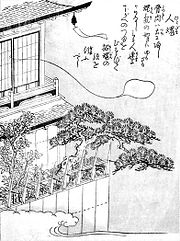Hitodama
Hitodama ( Japanese 人 魂 , to dt. "Human soul") describes a fictional being of Japanese mythology . It is assigned to the group of Yūrei ("ghosts").
description
Hitodama are often described as floating, blue or green fireballs with long, thread-thin tails. If they touch the ground, they should turn into countless black beetles or black coal lumps .
Lore
According to folklore , Hitodama hang out near cemeteries and in dark forests in summer. They are usually portrayed as harmless, play pranks, and are attracted to people with great mental powers. But they should also be able to become malicious, for example if their summoner has been murdered . Otherwise, Hitodama are often said to be the soul of unhappy people who cannot find rest after death.
origin
The legends to Hitodama may go on frequent in Japan Firefly such as Luciola cruciata ( 源氏蛍 , Genji botaru ; Engl. " Genji -Leuchtkäfer") and Luciola lateralis ( 平家蛍 , Heike botaru ; Engl. " Heike -Leuchtkäfer “) Back, snail-eating beetles and their larvae , whose rhythmic glow ( bioluminescence ) is famous throughout Japan. They were named after influential noble families from ancient times. In Fusa -Park of Tokyo is every year the so-called Hotarugari ( 蛍狩り ; "Firefly Catch" to dt.) Held.
Hitodama be easily with similarly appearing phenomena confused, for example, with the " fox fire " spells ( 狐火 , Kitsunebi ; to dt "Fuchs fire."), The wisp ( 鬼火 , Onibi ;. Engl "demons fire") and the ball lightning ( 火の玉 , Hinotama ; to German "fireball").
Hitodama in the modern subculture
Hitodama are a popular motif in modern manga and anime series, such as Inuyasha and Shaman King . In Inuyasha , the Hitodama appear as whitish clouds of light that are collected by the so-called "soul catchers" of the Miko Kikyo and fed to the latter so that they stay alive. In Shaman King , the protagonists (all of them shamans ) can summon Hitodama to use their abilities or their energy in battle.
literature
- Karen Ann Smyers: The fox and the jewel: shared and private meanings in contemporary Japanese inari worship. University of Hawaii Press, Honolulu 1999, ISBN 0-8248-2102-5 , pp. 117-118.
- Stephen Addiss , Helen Foresman: Japanese ghosts & demons: art of the supernatural. G. Braziller, Illinois 1985, ISBN 0-8076-1126-3 .
- Kazuhisa Fujie, Martin Foster: The Inu-yasha Experience: Fiction, Fantasy And Facts (= Volume 5 of: Mysteries and Secrets Revealed! ) DH Publishing, Tokyo 2004, ISBN 1-932897-08-9 , pp. 82-83.
- Hiroyuki Takei: Shaman King. Volumes 1-32. VIZ Media, San Francisco 2003–2011.
- Lloyd Vernon Knutson, Jean-Claude Vala: Biology of Snail-Killing Sciomyzidae Flies. Cambridge University Press, Cambridge (UK) 2011, ISBN 0-521-86785-1 , p. 24.
- Chris Philo, Chris Wilbert: Animal spaces, beastly places: new geographies of human-animal relations (= Volume 10 of Critical geographies ). Routledge, London / New York 2000, ISBN 0-415-19847-X , pp. 172-173.
Web links
- The Obakemono Project: Hitodama (English)
- Lexicon of the Yōkai. "Hitodama" section (Japanese)

